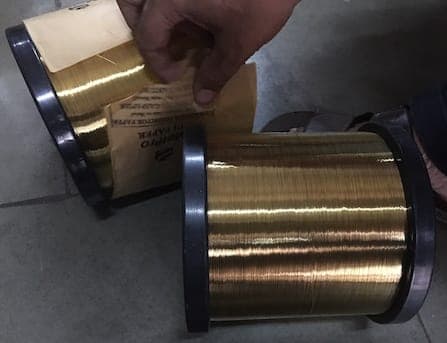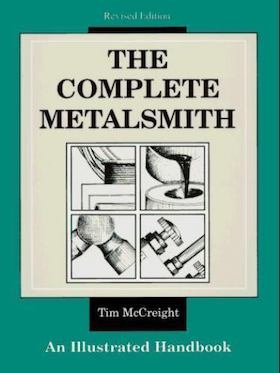
Curated with aloha by
Ted Mooney, P.E. RET

The authoritative public forum
for Metal Finishing 1989-2025

-----
How to anneal brass
Q. We are a small Brass Sheet producing mill based in India having small production capacities and small capital. I am looking for some simple / cost effective technique through which we can improve our annealing process.
The problem is as follows;
We have wood annealing furnace as well as electric annealing furnace. When we anneal brass sheets in these furnaces, the sheets become black due to oxidation of surface. What I want to know is can we use some gas (such as nitrogen etc) so that the oxidation does not take place and as such we get clear brass sheets. This will save us a lot of energy and time and costs.
Kindly let me know if you think this can work.
Saket GuptaB.G. Dhatu Udyog Ltd. - Yamuna Nagar, India
2001
A. If you can pressurize the oven with inert gas like argon or nitrogen I think it will work as long as all the oxygen is vented. A simpler way is to seal the sheet in a Stainless steel bag that is produced for this purpose.
Russell Richter- Danbury, Connecticut, USA
2001
Lighting mfgr. needs annealing spec. for Brass 270
Q. I am specifying a brass 270 alloy (extruded) bar to be used as a "bus bar" style lighting system. The shape is a 5/16" square bar with a 1/4" diameter hole located in the center. I am being asked to provide an "annealing spec" for it. Can someone provide me with some direction as to how to determine this spec? or if there is an existing spec for this alloy, what is the process? or how do I locate it?
Thank you,
Richard YoungDrafter for lighting mfgr. - Sonoma, California, USA
2003
A. I am unaware of any MIL specification for the heat treatment of alloy 270 (C27000, Yellow brass 65Cu-35Zn). ASTM B601, "Standard Classification for Temper Designations for Copper and Copper Alloys,Wrought and Cast", specifies resultant properties in a generic fashion but not process details. E.g., H02 indicates cold worked to ? hard, OS035 indicates annealed to an average 0.035 mm grain size.
ASTM B36, Standard Specification for Brass Plate, Sheet, Strip, And Rolled Bar, gives tensile strength and hardness values for C26800 (64Cu-36Zn) and C27200 (63Cu-37Zn) in various tempers. The values are nearly identical (except for spring hard) and should serve for C27000.
To specify an annealing, one needs initial material info and an objective. What is the grain size, the amount of prior cold working, the desired grain size and the amount of further cold working to be performed? Are you certain of the need for annealing? It will reduce the yield strength up to 80% dependent upon initial value. Typical annealing temperatures range from 425 to 750 °C. A relatively low temperature anneal, 1 hr at 300 °C, will yield a small grain size (better for polishing), while a higher temperature, 500 °C, may be necessary to achieve a 50% elongation via cold working. A protective atmosphere is recommended for higher temperatures to avoid oxidation. Testing of grain size or hardness for comparison with values from ASTM B36 or the references below is recommended.
I didn't find data on annealing C27000 to improve conductivity. From data for copper, I would guesstimate an improvement < 4 relative %, e.g., from 26% to 27% IACS.
For more annealing details and other properties, see ASM Metals Handbook Vol. 2 'Properties and Selection: Nonferrous Alloys and Special-Purpose Materials' [on Amazon affil links]. Physical properties of C27000 in cold worked (1/8, 1/4, 1/2, hard, extra hard and spring hard) and annealed (of various grain sizes) tempers can also be found on the Copper Development Association site at www.copper.org.
Ken Vlach [deceased]- Goleta, California
Rest in peace, Ken. Thank you for your hard work which the finishing world, and we at finishing.com, continue to benefit from.
2003
Multiple threads merged: please forgive chronology errors and repetition 🙂
Annealing a brass door handle
Q. I have an old 9" long solid brass door handle that screws into my front door by three screws at the top and three at the bottom (shaped kind of like the handle of a coffee mug). The screws at the bottom came off and the door was used that way for a year. Now it is slightly bent and cannot screw back down. I am going to mount it in a homemade jig to bend it back--and a friend also recommended I anneal it with a propane torch (I can't bend it very easily--if at all--right now). Is there any chance I would severely discolor the brass? If so, can I polish it back to normal? It is not shiny brass like a tuba or trumpet--it is more rough antique-looking. Any thoughts, caveats, recommendations?
Christopher GlennSelf - Edina, Minnesota, USA
2004
|
|
A. No, don't anneal it. It will get very brittle under heat and likely crack. Just slowly bend it back into place (i.e.--a little bit every day, let the metal return over time). Christopher Glenn- Edina, Minnesota 2004 2004 A. Annealing the piece before bending it is a very good idea, it will discolor due to the temper of the piece changing. The good of annealing it outweighs discoloring it. If you are worried about ruining whatever patina you have accumulated over the years, it can be reapplied chemically. 1 Tbsp ammonium chloride That will green the brass some, test it on a small part first to be sure that it will work as expected. If you want some more information on annealing let me know. Marc Banks- Elizabeth City, North Carolina |
A. "Annealing is the process of reducing stress within metal by heating it to a prescribed temperature. Industrially this is done in a furnace where the temperatures can be monitored mechanically. in the studio it is more common to anneal with a torch. Temperatures are gauged by the color progression of the metal, with a dimly lit area being best suited for this purpose. Paste flue may be painted onto the metal to serve as a temperature indicator: it is clear at 1100 °F (593 °C). If quenching in a pickle, beware of dangerous fumes and splashing acid. A safer method is to quench in water then slide the work into the pickle."
--The Complete Metalsmith by Tim McCreight .
Bronze Heat to a medium red; quench when the Copper redness disappears.
It is important to use the proper quench, I'd suggest the use of vegetable oil (take care it will ignite when you initially quench the piece!), I'm suggesting vegetable oil because it will cool the work slower than water and will protect the metal from oxidizing too much when heated. You can generally use whatever vegetable oil you can purchase at the local grocery store.
Annealing is a very important process to use when working non-ferrous metals as it reduces the stresses in the metals and keeps it from breaking. Don't anneal, and you run a very great risk of breaking the handle, you can (and I do suggest) working the handle cold and annealing as you go. Get a chunk of brass from the hardware store and get the feel of what I'm talking about before you do it.
Marc Banks- Elizabeth City, North Carolina
2004
June 17, 2014
Q. Hi,
I need some help with annealing small pieces of 6 mm solid round brass bars using a kiln oven.
1) What is the adequate temperature to be applied?
2) For how long the brass need to remain in the oven?
3) When done, should I cool it down with water or leave it to cool down naturally?
Thanks for your help !
Denny
- london, uk
Q. I have similar question to the above ... thanks for your help.
M. James- Volusia, Florida, USA
February 24, 2016
Q. We manufacture brass 80/20 , we are getting appropriate tensile strength,and shininess at the time of manufacturing! We draw it from 1.25 mm to 0.20 mm. And then we annealed it.

But after they we are facing oxidation! How can we overcome this problem? Please suggest.
Govind MAHESHWARIBrass wire drawing - Aligarh, Uttar Pradesh, India
September 10, 2016
A. The discoloration is coming from one or both of two causes. Either there is some organic film, like a thin oily layer, left on the wire after drawing: or the wire is getting hot enough to discolor in the furnace atmosphere. If it is the first, then cleaning is vital. If the latter, then changing the atmosphere would be wise. We age beryllium copper wrapped in aluminum foil while bleeding nitrogen through the wrapped assembly, and it works well. Perhaps something akin to that would assist you.

Lee Gearhart
metallurgist - E. Aurora, New York
October 5, 2016
Q. What do recommend cleaning with to avoid leaving any residue?
Erin Evans Fitz-JamesArtist - Toronto, Ontario, Canada
January 22, 2020
? Hi Erin. Can you flesh out your inquiry a bit? Govind's copper wire can be electrocleaned then rinsed in DI water, or it can be cleaned with perchlorethylene in a vapor degreaser. Other items can probably be cleaned with pumice
⇦ this on
eBay or
Amazon [affil links] and a scrub brush
⇦ this on
eBay or
Amazon [affil links] , then rinsed. But if there's no residue, what will stop it from immediately tarnishing?
Are you referring to before or after an annealing operation, or to the more general case of just removing soil & oil from copper? Thanks.
Regards,

Ted Mooney, P.E. RET
Striving to live Aloha
finishing.com - Pine Beach, New Jersey
January 2020
Q, A, or Comment on THIS thread -or- Start a NEW Thread
